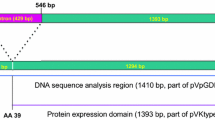Abstract
Increased drug resistance to anti-malarials highlights the need for the development of new therapeutics for the treatment of malaria. To this end, the lactate dehydrogenase (LDH) gene was cloned and sequenced from genomic DNA of Plasmodium vivax (PvLDH) Belem strain. The 316 amino acid protein-coding region of the PvLDH gene was inserted into the prokaryotic expression vector pKK223-3 and a 34 kDa protein with LDH activity was expressed in E. coli. Structural differences between human LDHs and PfLDH make the latter an attractive target for inhibitors leading to novel anti-malarial drugs. The sequence similarity between PvLDH and PfLDH (90% residue identity and no insertions or deletions) indicate that the same approach could be applied to Plasmodium vivax, the most common human malaria parasite in the world.
Similar content being viewed by others
References
Bernal A, Ear U, Kyrpides N (2001) Genomes online database (GOLD): a monitor of genome projects world-wide. Nucl. Acids Res. 29: 126–127.
Bzik DJ, Fox BA, Gonyer K (1993) Expression of Plasmodium falciparum lactate dehydrogenase in Escherichia coli. Mol. Biochem. Parasitol. 59: 155–166.
Dunn CR, Banfield MJ, Barker JJ, Higham CW, Moreton KM, Turgut-Balik D, Brady RL, Holbrook JJ (1996) The structure of lactate dehydrogenase from Plasmodium falciparum reveals a new target for anti-malarial design. Nat. Struct. Biol. 3: 912–915.
Gomez MS, Piper RC, Hunsaker LA, Royer RE, Deck LM, Makler MT, Vander Jagt DL (1997) Substrate and cofactor specificity and selective inhibition of lactate dehydrogenase from the malarial parasite P. falciparum. Mol. Biochem. Parasitol. 90: 235–246.
Kain KC, Brown AE, Lanar DE, Ballou WR, Webster HK (1993) Response of Plasmodium vivax variants to chloroquine as determined by microscopy and quantitative polymerase chain reaction. Am. Soc. Trop. Med. Hyg. 49: 478–484.
Nwaka S, Ridley RG (2003) Virtual drug discovery and development for neglected diseases through public-private partnerships. Nat. Rev. Drug Discov. 2: 919–928.
Oelshlegel Jr FJ, Brewer GJ (1975) Parasitism and the red blood cell. In: Surgenor DM, ed. The Red Blood Cell. New York: Academic Press, pp. 1263–1302.
Olliaro PL, Yuthavong Y (1999) An overview of chemotherapeutic targets for anti-malarial drug discovery. Pharmacol. Ther. 81: 91–110.
Roth Jr EF, Calvin MC, Max-Audit I, Rosa J, Rosa R (1988) The enzymes of the glycolytic pathway in erythrocytes infected with Plasmodium falciparum malaria parasites. Blood 72: 1922–1925.
Royer RE, Deck LM, Campos NM, Hunsaker LA, Vander Jagt DL (1986) Biologically active derivatives of gossypol: synthesis and anti-malarial activities of peri-acylated gossylic nitriles. J. Med. Chem. 29: 1799–1801.
Sambrook J, Russell DW (2001) Molecular Cloning: A Laboratory Manual, 3rd edn. New York: Cold Spring Harbor Laboratory Press.
Sherman IW (1979) Biochemistry of Plasmodium (malarial parasites). Microbiol. Rev. 43: 453–495.
Turgut-Balýk D, Holbrook JJ (2001) Determination of the DNA and amino acid sequences of the lactate dehydrogenase gene from Plasmodium falciparum strains K1 and Pf FCBR: a route to the design of new anti-malarials. Turk. J. Biol. 25: 241–250.
Turgut-Balýk D, Shoemark DK, Moreton KM, Sessions RB, Holbrook JJ (2001) Over-production of lactate dehydrogenase from Plasmodium falciparum opens route to new anti-malarials. Biotechnol. Lett. 23: 917–921.
Author information
Authors and Affiliations
Rights and permissions
About this article
Cite this article
Turgut-Balik, D., Akbulut, E., Shoemark, D.K. et al. Cloning, sequence and expression of the lactate dehydrogenase gene from the human malaria parasite, Plasmodium vivax . Biotechnology Letters 26, 1051–1055 (2004). https://doi.org/10.1023/B:BILE.0000032958.78158.10
Issue Date:
DOI: https://doi.org/10.1023/B:BILE.0000032958.78158.10




